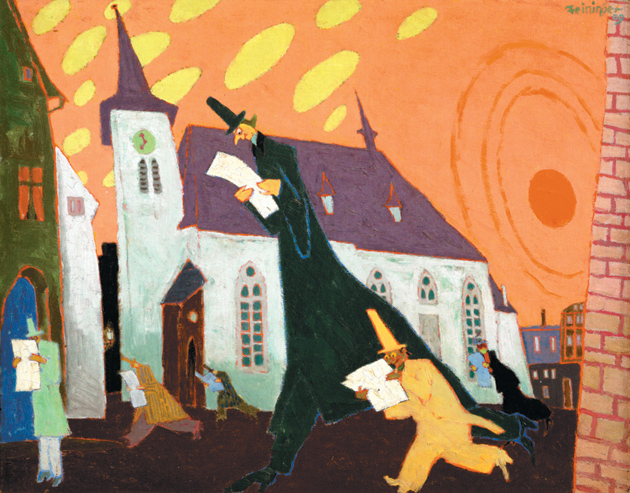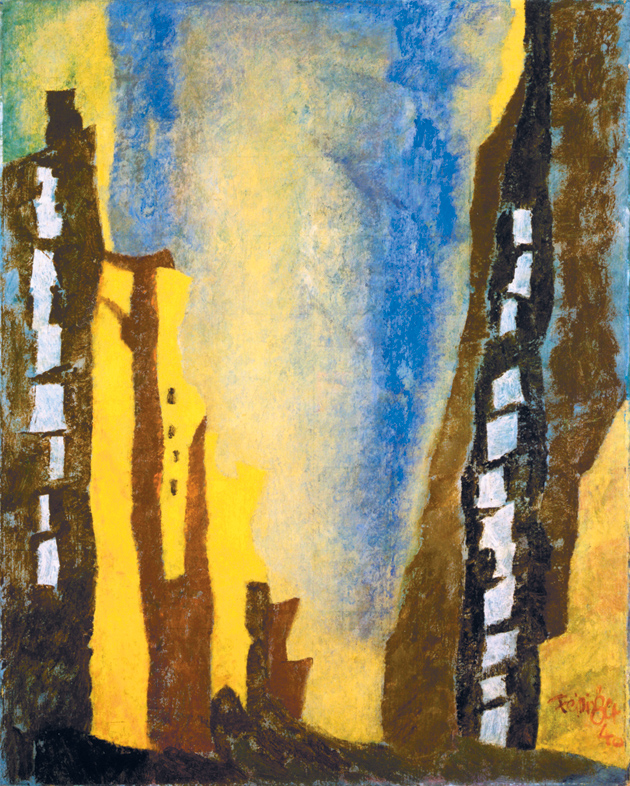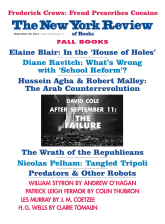About ten years ago I began seeing now and then, whether in books or galleries, fanciful and brilliantly colored pictures by Lyonel Feininger (1871–1956) that—made when he was first painting, and showing people doing this or that—had an exuberant, even anarchic spirit that seemed at odds with his temperament. Like others, I suspect, I thought of the German-American painter as one of the somewhat retiring second lieutenants, so to speak, of modern art. He was an artist whose stylishly designed images of angular and elongated buildings seen in hushed moments and of stilled seacoasts had more substance than, say, the work of the now-little-known (and sometimes delightful) Jacques Villon but were less scintillating or forceful than pictures by Dufy or John Marin. Feininger was one of the first artists Walter Gropius appointed to be a “master” at the Bauhaus in 1919, and he remained there in different capacities for years. Yet it didn’t seem odd that in Nicholas Fox Weber’s richly detailed The Bauhaus Group (2009) we hear a lot about Klee, Kandinsky, Josef Albers, and others associated with the school while Feininger is mentioned only in passing.
Feininger is now the subject of a retrospective at the Whitney. Organized by Barbara Haskell, who is the principal author of its authoritative accompanying catalog, it is the only full-dress survey the artist has had in a New York museum since, unbelievably, 1944. It probably won’t radically change the way he is thought about. Yet it includes an eye-opening display of his early paintings (which had almost no part in his 1944 exhibition), and, taken along with some surprises from later in his life, it certainly makes one rethink his reputation. During the years 1907 to 1911, Feininger, it is now clear, had one of the most oddly brilliant beginnings of any twentieth-century painter. His works from this moment have an enchanted atmosphere and might hold a six-year-old’s attention, but they also capture the way fantasy and disquietude can coexist at any time.
From picture to picture we have little sense of what is coming next. Some of Feininger’s people, wearing comically massive crinolines or wildly elongated stovepipe hats, take us to the Romantic, or Biedermeier, period of the 1830s. The wonderful and wonderfully silly 1907 The Proposal (which is in the Whitney’s catalog but not in its show), where our foppish protagonist warily presents himself to three belles in a room with pink walls, is, oddly, a picture that manages to be absorbingly informative about early-nineteenth-century clothing while feeling totally contemporary to our eyes. Most of the pictures, though, are street scenes where the walkers (and streetwalkers) have more to do with the early-twentieth-century world—even while the buildings these people are surrounded by are hard to place in time and we keep seeing those out-of-date hats.
Trotting this way or that, or sometimes waddling or slumping along, Feininger’s people could be going to a costume party, to their jobs, or, in pictures that suggest the social stress of the period leading to World War I, to a political demonstration. Every now and then, like figures in a dream, they will be as tall as the buildings around them. Their bodies form jagged or elongated, or bulky or rounded, self-contained shapes, and these shapes play off one another with a jumpy, syncopated rightness. Just as beckoning are the paint surfaces of the works, which are quietly lush and ask to be touched.
The most amazing element may be Feininger’s lollipop colors. In his extraordinary 1907 The White Man, which is known to be a self-portrait, our pipe-smoking and stupendously tall protagonist—he is as high as a nearby church tower and bends his neck so as to fit in the image—is like a nearly all-white silhouette cutout. And this daring whiteness, laid on with a cream-cheese thickness, galvanizes the picture’s very particular hues of blue, green, and red. In the deliriously inventive 1909 Newspaper Readers, the stovepipe-hatted, long-coated, and goonish striders, their attentions held by the papers they read, miss seeing the yellow clouds shaped like oblong cookies that zoom in formation through the orange sky.
Something of the unlikely, even explosive power of these works may stem from the fact that when he began making them Feininger was thirty-six, which is relatively late in life to start painting. At the same time he happened to have been for years one of the most famous cartoonists and caricaturists in Germany. But these are only some of the unusual and dramatic details about him and how he arrived at this moment. He was born on St. Marks Place, in New York City, to parents of German descent who were concert musicians and who expected that their violin-playing son would become a musician himself. But although Lyonel would remain involved with music all his life, he had been from boyhood an almost compulsive sketcher of trains and boats and zany incidents. When his parents, as he later wrote, “dumped” him in Germany in 1887, at sixteen, to study violin, he managed to get himself into an art academy instead.
Advertisement
Some two decades and thousands of published satirical drawings later—and never having returned to the States—he was now married to a German woman and the father of two daughters. He had also fallen in love and begun an affair, in 1905, with a married woman named Julia Berg, née Lilienfeld, and before their respective divorces came through they began living together. They traveled and sketched in the picturesque old villages around Weimar, and he shared with her his enthusiasm for Victor Hugo and the literary culture of the 1830s. In 1906 they moved for a spell to Paris, where Julia gave birth to their (illegitimate) child. There Feininger encountered and was excited by the new painting style of the moment, already known as Fauvism. Led by Matisse and Derain, it was an art of intense color that owed much to van Gogh.
How Feininger jumped from these personal, literary, architectural, and artistic stimuli into making his first paintings probably owed most to Julia. In their eventual marriage, she functioned equally as Lyonel’s muse, superego, business counselor, and the mother of his three sons. Her allowance from her father enabled them to live during rough stretches. Not least, it was Julia who suggested, in 1907, that Feininger, in his new painting, work from moods and images he had developed as a caricaturist. Encountering these details in Haskell’s impressively researched biography certainly dispels some of the mystery of pictures such as The White Man and Newspaper Readers. But the information does little to alter the sense that the works, which blend a storybook sense of the past with a cartoon cheekiness, defy categorization.
Yet the very factors that helped make his early paintings so remarkable—that Feininger was loaded with skills as a graphic artist and had no preconceptions as a painter, and had just had a romantic, life-changing experience—left him a little bereft, and vulnerable, the morning after. In 1911 he discovered in Paris the then new art of Cubism, and while it clearly spoke to something deep in him, it also, in a sense, swallowed him whole. He was still capable of making, in 1912, the marvelously weird Angler with Blue Fish II, where what might be called gentlemen fishermen of the 1830s pass by a radiant expanse of yellow sea with boats in the distance. But Cubism, with its proclivity for a graphic tidiness, effectively killed his desire to make paintings where figures, however cartoonish, have a real presence and express some mischief and tension.
The attenuated work some of us associate with Feininger essentially takes over from this time. In pictures that we see in all too great a number at the Whitney, we are given an art of excessively sharp-edged, intersecting planes, held in place or defined by thin lines, where figures, when they are in the scenes, are either specks or mincing, decorative emanations of the cubistic webbing. Feininger in 1927 made a painting called Broken Glass, which shows shards of glass stacked one before the other. From its title alone, the picture can stand as an emblem of the tenor of his characteristic work. Whether he shows cities or the sea, and whether his whispery mood is labeled “Gothic” or “Romantic,” he makes us feel that we look at carefully arranged stacks of precisely jagged pieces of variously tinted glass.
The creator of these pictures is, to be fair, a master of technique. Much painstaking craftsmanly labor obviously went into these views of rhythmically fractured spaces, where a soft light is filtered through countless overlapping planes. And although Feininger’s feeling for an art of order and balance is not emotionally engaging, it certainly gripped him profoundly. As shown in Haskell’s biography and in Bryan Gilliam’s essay in the catalog on Feininger and music, his desire for an art that had nothing to do with one’s “self” but expressed rather, as Haskell puts it, “cosmic,” “spiritual,” or “otherworldly” truths was crucially important to him.
One can wonder whether making an art of tones and shapes alone stemmed from the part of Feininger that, disregarding the wishes of his music- performing parents and becoming instead a cartoonist, wanted to make peace with his parents—especially with his father, Karl, who, besides also teaching and composing music, believed in its “metaphysical” properties and saw relationships between tempo and color. Perhaps on some level Lyonel was paying his dues. If so, he paid wholeheartedly. Taught violin by Karl, he added piano and organ on his own, and he played one instrument or another almost daily. He was overwhelmed by Bach, and seemed to see the composer as a guide for painting. In the 1920s he even wrote fugues, which were performed in public on occasion.
Advertisement
Feininger’s quest for harmonic balance also marks his photography, which is part of the Whitney show and is the subject of its own traveling exhibition organized by the Harvard Art Museums. Bowing to Julia’s sense that this side of him was best kept private (she felt similarly about his music), Feininger never publicly showed his photographs, which he began making in earnest in the 1920s, when he was at the Bauhaus. He photographed the sleekly modern residences there on misty nights, and he went on, over the years, to shoot, among other things, railroad yards in the snow, model sailboats, and store windows with mannequins. As seen in the Harvard and Whitney catalogs, he hardly made a photo that isn’t touched by a graceful angle or doesn’t sensitively capture some diffuse light. Looking at more than any ten or so, however, the mind wanders. Something personal, or quirky, is missing.
Perhaps Feininger’s most original, or most unexpected, expression of his feeling for a cosmic order can be found in one of the comic strips he made just before he began to paint. This was Wee Willie Winkie’s World, which overlapped with the run of his other full-page, full-color strip, The Kin-der-Kids, in the Chicago Sunday Tribune in 1906 and 1907. (Feininger, who was hired by the Tribune because of his fame as a satirical graphic artist in Europe, didn’t move to Chicago for the job.) For historians of the comics, these two strips have long been spoken of in the same breath as Winsor McCay’s Little Nemo in Slumberland, which began in 1905, as works that showed, at the moment when the idea of the funnies was taking off, just how much a master comic-strip creator could accomplish.
Neither of Feininger’s strips, examples of which are in the current show, has quite the hallucinatory graphic or storytelling power of Little Nemo (what does?). The Kin-der-Kids, which concerns a troop of mismatched adventurers who get into scrapes throughout the world, has plenty of terrifically drawn scenes, but the narrative is a little conventional. (The boys are often fleeing Auntie Jim-Jam and her obsession to keep administering castor oil.) Wee Willie Winkie, though, which is about a little fellow who wanders through the landscape and sees everything in anthropomorphic ways, has extraordinary poetic passages.
On one jaunt, he encounters a windmill that has angered the moon by ripping a hole in a cloud that covers it—and then sees the windmill mollify the moon by sewing the cloud back together. Wee Willie, it dawns on you, is an artist. He sees the world outside himself as totally alive, no matter what it is. But he is also, especially for a comic-strip hero, rather passive, almost faceless, and this may have contributed to Feininger’s work for the Tribune coming to an end after nine months.
The spiritual or Wee-Willie-ish Feininger is always the least of him. It is his alter ego—the boy-man who periodically needed time off from building cosmic structures—who we look for. Bits of him are there in charmingly punchy tiny woodcuts, dating from the late Teens, which are often of groups of men and old ships. (Not much in evidence at the Whitney, they are the highlight of a concurrent show at Moeller Fine Art.) Some of the paintings he made after his world was seriously jarred in the late 1930s are free of his glassy perfectionism as well. In all the many years he resided in Germany, Feininger never relinquished his American citizenship; and when, with the advent of Hitler, life became difficult for him and his family because his work was considered “degenerate” and because Julia was Jewish, he accepted an offer, which came in 1936, to teach at Mills College, in California. Beginning in 1937, when he taught at Mills again and left Germany for good, he resumed an American existence he had dropped in 1887.
Life in New York, where he and Julia eventually settled at 235 East 22nd Street, proved immensely difficult at first. They hadn’t been allowed to take any currency out of Germany, and he was a barely known artist in America at a time when modern art of any stripe was finding few buyers. They skirted poverty for years. Yet the rocky times he experienced shook free his painting a little. At the Whitney show, the 1941 The Night Express, an oil painting of a 1918 woodcut, has a snorting energy to it, and there is a tingling grace to the mostly blue 1940 Manhattan Night.
Feininger’s spunkiness came forth most winningly in the carved and painted wood toys, many only a few inches high, which he began making from around 1913 every Christmas for his children and then for friends. These blocky, brightly colored little figures and houses (and trains, bridges, animals, and old sailing vessels) have been seen here and there over the years, but Haskell has brought together more than have ever been seen at once, and it is likely that they will be almost as much of a revelation as Feininger’s first crop of paintings. Taken along with those paintings, they show that his art is most alive simply when he could put people, and people at their most antic and unhinged, at center stage.
Especially for viewers familiar with the haunting, very small cast-iron chair and house structures that Joel Shapiro made in the 1970s, or with the beguiling minuscule items of apparel that Charles LeDray has been making more recently, Feininger’s figures, in their medievalish long cloaks, and sometimes smoking pipes, can be seen as a kind of sculpture. Yet these often tilting people are evidently toys. They look played with, and their scuffed surfaces and the sense they give of having been made with speed add to their appeal.
Wearing hats that are sometimes as big as their bodies, and with their quizzical, big-nosed faces, the figures have a surprising amount of human character. But this will be difficult for viewers to perceive at the show, fine as the installation is. The pieces are simply too small to take in unless they are in front of your eyes. The best place to see them is in Lyonel Feininger: City at the Edge of the World (1965), a treasure of a book put together by two of the artist’s sons. Its text is by T. Lux Feininger, who was a painter and a lively photographer in his youth at the Bauhaus (and who has just died), and the black-and-white and color photographs of the toys are by Andreas Feininger, who developed a considerable reputation as a photographer, much of it coming from his work for Life. (Their brother Laurence was a Catholic priest and a music historian.)
In some of the photographs the little figures are arranged (one feels by both sons) in scenes where the characters mill, or stand on cliffs and look out to sea, and even convey, as in the 1909 Newspaper Readers, the foreboding that can go hand in hand with make- believe. These setups might sound like a monkeying with the toys. But the effect is that, knowing very well their father’s own genius for monkeying around, his sons were able to make a real gift to his spirit: a posthumous extension of his work.
This Issue
September 29, 2011
School ‘Reform’: A Failing Grade
Coming Attractions
After September 11: The Failure





